|
The
|
THE BURGENLAND BUNCH NEWS - No. 273 January 31, 2017, © 2017 by The Burgenland Bunch All rights reserved. Permission to copy excerpts granted if credit is provided. Editor: Thomas Steichen (email: tj.steichen@comcast.net) Archives at: BB Newsletter Index Our 21st Year. The Burgenland Bunch Newsletter is issued monthly online. It was founded by Gerald Berghold (who retired from the BB in the Summer of 2008 and died in August 2008). |
| Current Status Of The BB: * Members: 2501 * Surname Entries: 8003 * Query Board Entries: 5576 * Staff Members: 13 |
|
1) THE PRESIDENT'S CORNER (by Tom Steichen)  After
the bits and pieces here in my "Corner" (which I hope you find interesting and/or useful!), we
continue with Article 2, which is something I wrote, by request, for publication in the
Burgenländische Gemeinschaft newsletter about the BB Completing 20 Years
in Existence. The article appears therein in the German language, compliments of a
translation by BB VP Klaus Gerger (thanks Klaus!). After
the bits and pieces here in my "Corner" (which I hope you find interesting and/or useful!), we
continue with Article 2, which is something I wrote, by request, for publication in the
Burgenländische Gemeinschaft newsletter about the BB Completing 20 Years
in Existence. The article appears therein in the German language, compliments of a
translation by BB VP Klaus Gerger (thanks Klaus!). Article 3 speaks to the Hungarian Refugee Crisis of 1956-7 that occurred when Austria opened its border and offered asylum to exiles from the Hungarian Revolution of 1956. Speaking of anniversaries, it is 60 years since that occurred. Article 4, is a write-up about New Features at the DNA.Land website, as well as a description of the tools provided to explore matches. Up until recently, I had no matches at DNA.Land but, now that I do, I can tell you about it! The remaining articles are our standard sections: Historical Newsletter Articles, and the Ethnic Events and Emigrant Obituaries sections. 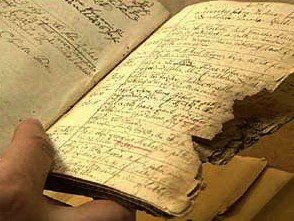 Digitization
of the Burgenland (Eisenstadt) Catholic Diocese Church Books: New information has been
shared that the Catholic Church Books for Burgenland are again being digitized and that some may
be online by mid-year 2017! Digitization
of the Burgenland (Eisenstadt) Catholic Diocese Church Books: New information has been
shared that the Catholic Church Books for Burgenland are again being digitized and that some may
be online by mid-year 2017!BB Member Patrick Kovacs writes: Hello Tom, there are two sources for this information. Ingrid Fleischer from the German language Facebook group "Ahnenforschung Burgenland" shared a letter from Bernhard Weinhäusel (head of the Diocese Archive in Eisenstadt) stating that the church books are currently [being] scanned and that a part of the collection should be available online by mid 2017.
Editor: which I translate as:
Patrick continues: The other source is user D. J. B. on "Forum
Ahnenforschung" who was told at his last visit of the Archive that Villages A-F are finished
and G-parishes are not available because they are being scanned at the moment.
Editor: Thus you now know what I know, and it does appear to be great news.
Let's hope that the initial batch of scanned images is available by mid-year, as indicated by
Weinhäusel, and that rapid progress is made in adding the remainder. By the way, Wikipedia has a good article on the old Kurrent German script:
https://en.wikipedia.org/wiki/Kurrent
And GoogleTranslate popped out this:
Clearly, I had transcribed the last word improperly, but every other transcription of that
word I tried led to similar gibberish. Nonetheless, it seemed apparent that what it told me
(despite GoogleTranslate's weird sentence construction) was that Franciscus used the
Bauer surname throughout his life but was born with surname Bausz.
She also included the baptism index record for Franciscus Bausz (which I also had
found after realizing the import of the Comment and the "extra words" in his name). Thus
the Comment allowed me to take his line back a generation and, should I decide to pursue
it, possibly even further back (which is something the Bauer name could never had done). Her blog is at
http://simplyburgenland.blogspot.com and below is an example blog. I occasional read her
comments and find them whimsical yet informative (in small ways) about Burgenland. Perhaps you
might find them so too...
and all of a sudden, comprehension hit me with an accompanied need to double up with
laughter...
...bubbling with laughter I answered, that the Bobster was very fine indeed. Yes, Gatte
in German means husband.
|
2) TWENTIETH ANNIVERSARY OF THE BURGENLAND BUNCH [Ed Note: The following article, after translation to the German language by Klaus Gerger, was published in the most recent BG Newsletter.]  The
Burgenland Bunch (BB) is celebrating its twentieth anniversary in 2017. The BB was founded
in January 1997 when Gerald Berghold (1930–2008), grandson of four emigrant Burgenländers,
published the first issue of an e-mail newsletter called "The Burgenland Bunch News,"
which he sent to a small group of correspondents who were interested in Burgenland. The BB has
since grown into an international, internet-based, volunteer organization, dedicated to the
genealogy and history of Burgenland and formed to foster preservation of Burgenland ethnic
heritage and memory of the Burgenland Auswanderung. The
Burgenland Bunch (BB) is celebrating its twentieth anniversary in 2017. The BB was founded
in January 1997 when Gerald Berghold (1930–2008), grandson of four emigrant Burgenländers,
published the first issue of an e-mail newsletter called "The Burgenland Bunch News,"
which he sent to a small group of correspondents who were interested in Burgenland. The BB has
since grown into an international, internet-based, volunteer organization, dedicated to the
genealogy and history of Burgenland and formed to foster preservation of Burgenland ethnic
heritage and memory of the Burgenland Auswanderung.Although the generation of emigrants and their children is becoming smaller, Gerry tapped into the growing awareness of ancestry among the third, fourth and fifth generations. Thus he defined the "Bunch" as "a homogeneous grouping—in this case, descendants of Burgenland immigrants, loosely connected by a website and a newsletter." From an initial mailing to just 12 correspondents, its monthly English-language newsletter now reaches over 2500 BB members residing in every US state and many countries of the world. Gerry Berghold edited and published the initial 176 editions of the newsletter. Hannes Graf (Vienna, Austria) became Editor in September 2008, publishing 24 editions. Thomas Steichen (Greencastle, PA) became Editor in August 2010 and has, so far, published over 70 editions. The BB website, which is visited by about 9,000 people each month, documents over 8,000 Burgenland emigrant family names and holds extensive historical and genealogical resources. It is the archive for the newsletter, the host for the Members and Surnames databases, a repository for maps and cross-references of Burgenland villages through their Hungarian, German, and Croatian names, a source for locations of parishes and municipal offices and for available church and civil records, and a provider of links to many other websites that relate to Burgenland. Its affiliated sub-site, BH&R, documents and honors over 21,000 Burgenland emigrants who are buried in the United States and Canada. A joint US and Austrian staff of thirteen volunteers supports the organization and its website, www.the-burgenland-bunch.org, provides input to the newsletter, and/or provides answers and advice. The BB is currently led by President Thomas Steichen and Vice President Klaus Gerger (Vienna, Austria), who were assigned those titles in April 2007 when Gerry Berghold’s failing health forced him to transfer day-to-day control of the BB to the "managing directors" of the BB, as he called them, who worked with him then in his role as "chief operating officer." Gerry took on the new title of "BB Founder and Consulting Editor." In addition to Tom and Klaus, Johnny Santana (Brentwood, NY), Alan Varga (Bloomingdale, IL) and Frank Paukowits (Flushing, NY) are now part of the Managing Staff of the BB website. Tom handles the Home page and is the Editor of the monthly Newsletter, Klaus handles Austrian Contacts, Maps, Houselists and Research, Johnny handles the Membership pages, Alan handles the URL/Links page and Frank is in charge of the Burgenländers Honored and Remembered (BH&R) part of the BB website and leads a Burgenland-based DNA study. BH&R was created in 2003 and became affiliated with the BB in 2008. There are also eight Contributing Editors who provide articles, research services and expertise on specific areas: Fritz Königshofer (Bethesda, MD), Tom Glatz (Chicago, IL), John Lavendoski (Seattle, WA), Bob Strauch (Allentown, PA), Margaret Kaiser (Northvale, NJ), Emmerich Koller (Winnetka, IL), Willi Schmidt (Allentown, PA), and Terry McWilliams (Bellefontaine Neighbors, MO). Of this current group of 13 volunteers, only two (Fritz, Tom G.) were on Gerry’s initial Staff of 11, as published at the end of 1998. One of the goals established at the founding of The Burgenland Bunch was to develop an archive of English-language articles about Burgenland history and culture. The newsletter (and its archives) was the medium by which this goal was to be accomplished. As of the 100th edition in October of 2001, founder Gerry Berghold noted that there had been "some 1,300 articles in all" of which some 400 were of "major interest" (i.e., important to research). For the 200th edition in June of 2010, then-Editor Tom Steichen estimated that "we are around 2,500 articles now and have substantially increased the count of research-quality articles. We continue to be the largest source for English-language information about Burgenland, a claim that made Gerry Berghold proud and one that pleases me also." Since 2010, the newsletters have had fewer (but longer) articles in each edition, adding only an additional 500 articles, nearly 300 of which might be called research-quality articles. The BB website is also the authorized archive for BG newsletters older than five years. That archive currently holds the 416 BG newsletters from its initial edition, dated Frühling 1956, through 2010. Year 2011 is soon to be added. A special goal for the BB, or "a treasured dream," as Gerry Berghold wrote in 2000, was an English-language translation of Dr. Dujmovits book, "Die Amerikawanderung der Burgenländer." That goal was met with the publication by the BB in 2013 of an authorized English translation of the book's Third Edition, thus making the book accessible to the many English-only readers in the BB and BG. To date, over 1100 copies of the English issue have been purchased. As an organization, The Burgenland Bunch identifies and addresses areas of original research which shed light on the lives of Burgenland ancestors. It provides English-language translations of heretofore untranslated material. It offers membership to descendants and lists and archives their family data, maintaining it on the internet website. The BB also links researchers through an e-mail network, engages actively in uncovering records available for genealogical research, provides assistance in reading German and Hungarian script and deciphering archaic terms, and helps locate original villages based upon emigrants’ Hungarian, German and Croatian names and identifies parishes and locations of municipal offices and available church and civil records. All of this is done with the goal of expanding Burgenland family history, sustaining the memory of immigrant ancestors and retaining links with the homeland. Of special significance, the Burgenland government has chosen to honor many members of the BB staff for their commitment and contributions to Burgenland through their work with the BB. Gerald Berghold, Tom Steichen, Bob Strauch, Tom Glatz, Frank Teklits, Anna Kresh, Frank Paukowits, Fritz Königshofer and Margaret Kaiser all have been awarded medals (Ehrenzeichen, Verdienstkreuz, Goldene Medaille, or Silberne Medaille) by the Burgenland government in recognition of work performed through The Burgenland Bunch. In addition, the Burgenländische Gemeinschaft declared both Gerry Berghold and Tom Steichen as lifetime honorary members (Ehrenmitglied) of their association. On August 29, 2008, after five years of battling cancer, Gerry Berghold passed away in his home in Winchester, VA, having officially retired from The Burgenland Bunch less than a month before. In honor of his life and commitment to Burgenland history, The Burgenland Bunch website was dedicated to his memory. |
3) DECONSTRUCTION OF A MYTH? AUSTRIA AND THE HUNGARIAN REFUGEES OF 1956-57 (by Andreas Gémes) [From: Time, Memory, and Cultural Change, IWM Junior Visiting Fellows’ Conferences, Vol. XXV © 2009 by the author. Readers may redistribute this article to other individuals for noncommercial use, provided that the text and this note remain intact. This article may not be reprinted or redistributed for commercial use without prior written permission from the author. If you have any questions about permissions, please contact Klaus Nellen at IWM. Preferred citation: Gémes, Andreas. 2009. Deconstruction of a Myth? Austria and the Hungarian Refugees of 1956-57. In: Time, Memory, and Cultural Change, ed. S. Dempsey and D. Nichols, Vienna: IWM Junior Visiting Fellows’ Conferences, Vol. 25.] Editorial note: It is 60 years since the Hungarian Revolution of 1956 and the resulting refugee crisis of 1956-7 that occurred when Austria opened its border and offered asylum to all. Thus this reprint is both historically and currently timely, especially in light of Austria's continuing role in the current-day ongoing, largely Syrian, refugee crisis. I suspect you will find parallels between our contemporary issues and those of 1956. Introduction The wave of refugees created by the 1956 Hungarian revolution constitutes a particularly interesting example of political migration. When studying this exodus and its effects, Hungary’s western neighbour Austria deserves special attention since it was the country that at first received the majority of the refugees. Large-scale refugee movements typically have important political and security repercussions for both the sending and receiving of countries. Judged by today’s standards—with the routine news in the apathetic “first” world of tens of thousands of refugees desperately trying to enter Europe in search of a brighter future—it seems almost amazing how positively, even passionately, the Hungarian refugees were welcomed in Austria and elsewhere in the West. The fact that 1956 represents an exceptional and fascinating moment in migration history may explain why in Austria these events tend to be remembered in a highly positive way. It is often the case that contemporary Austrian witnesses have their own personal story to tell of Austria’s impressive humanitarian performance. In May 1957 the Austrian Interior Minister Oskar Helmer stressed in a session of the council of ministers that Austria had made “a good impression” because of its willingness to help the refugees. He continued: “We have earned ourselves a name in the entire world because of the refugees”. [1] Both Austrian and foreign scholarship on this topic almost unanimously agrees on this positive evaluation of Austria’s role in sheltering the refugees. During the fiftieth anniversary of the Hungarian revolution in October 2006, the truism of Austria’s selfless provision of aid was hardly questioned, as newspaper articles, exhibitions, and above all official ceremonies celebrated Austria’s positive role in 1956. [2] There is no doubt that the efforts of the Austrian people were indeed outstanding. As the popular American novelist James A. Michener wrote in his famous book The Bridge at Andau, which was based on interviews he conducted with Hungarian refugees in Austrian refugee camps, “It would require another book to describe in detail Austria’s contribution to freedom. I can express it briefly only in this way: If I am ever required to be a refugee, I hope to make it to Austria.” [3] The sheer magnitude of Austria’s efforts is amply demonstrated in the countless thankful notes from Hungarians (and non-Hungarians) from all over the world now in the Austrian State Archive in Vienna. To cite just one example, the following letter reached the Austrian Foreign Ministry from Brisbane, Australia: “We, the Hungarian Community in Brisbane, wish to express our most sincere gratitude for the help your government extended to our brave compatriots wounded in their desperate struggle for freedom. During the centuries your country has often helped us in our historical role of being Europe’s bulwark against the hordes of the East, but help has never been more appreciated than in this critical hour.” [4] In the midst of all this (self-)praise, it is all too easy to forget that Austria was cast into a very delicate situation due to the influx of the Hungarian refugees for which it was not prepared in terms of either resources or infrastructure. The aim of this paper is to present, on the basis of archival material, a more balanced picture of the reception of the Hungarian refugees by highlighting how Austria struggled to handle the situation. It will be shown how Austria as a state reacted to this difficult situation and how different institutions—ministries, charity organisations, and the United Nations—managed to work together to resolve the crisis. The 1956 Hungarian revolution and Austria Austria received its state treaty and full sovereignty in May 1955 after a decade of occupation by Allied forces. The Hungarian crisis, which broke out on October 23, 1956, constituted its first serious foreign policy crisis. [5] When the Soviet troops used brutal military force to crush the thirteen-day revolt, Austria had to put into effect the neutrality it had adopted only a year before. While the Austrian population and its leadership (except the politically isolated and unimportant Austrian communists) clearly sympathized with the freedom-fighting Hungarians, the Austrian government had to live up to its neutral status and carefully measure its reactions. In particular, its border was secured to prevent any interference from Austrian territory. Its prominent role in connection with the Hungarian uprising was initially to allow those people fleeing Hungary to enter Austria and subsequently to direct them on to other countries. Its humanitarian efforts were acknowledged world-wide, apart from of course the Soviet Union and its satellites, who accused Austria of having allowed “reactionary elements” and weapons to cross the Austrian-Hungarian border and thus of having violated its neutrality. A breaking wave of refugees Although refugees were already a familiar sight in Austria in the 1950s, [6] the massive influx of Hungarian refugees proved to be an exceptional moment in Austrian history, even if its long term role was primarily to act as a first place for asylum and a hub for collecting refugees in preparation for further movement elsewhere. 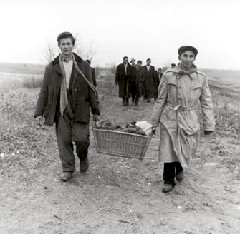 At
the outbreak of the revolution and during the early days of fighting, there was little to worry
about because the number of refugees was relatively small. At this point only 3,000 to 4,000
people crossed into Austria. [7] The Austrian authorities sent a telegram to their embassies in
Paris, London, and Washington requesting help, but at that time they did not expect a large
influx of refugees. After all, many Austrian officials seemed to believe that the revolution
would be victorious and a flood of refugees was unlikely to occur. Nevertheless, the Austrian
Minister of the Interior Oskar Helmer proclaimed as early as October 26 that asylum would be
granted to all Hungarian refugees, regardless of their reasons for leaving their home country.
[8] At
the outbreak of the revolution and during the early days of fighting, there was little to worry
about because the number of refugees was relatively small. At this point only 3,000 to 4,000
people crossed into Austria. [7] The Austrian authorities sent a telegram to their embassies in
Paris, London, and Washington requesting help, but at that time they did not expect a large
influx of refugees. After all, many Austrian officials seemed to believe that the revolution
would be victorious and a flood of refugees was unlikely to occur. Nevertheless, the Austrian
Minister of the Interior Oskar Helmer proclaimed as early as October 26 that asylum would be
granted to all Hungarian refugees, regardless of their reasons for leaving their home country.
[8]The few refugees who came before early November did not cause any embarrassment for the authorities. However, this state of affairs soon changed dramatically. On November 4 Soviet troops mounted a powerful intervention, aiming to crush the revolt. Suddenly, the hopes of a victorious revolution vanished and gave way to the fear of Soviet repression and reprisals. The massive influx of people into Austria started in the early morning of that day. Although the authorities had been preparing for an arrival of refugees, this mass immigration exceeded all their calculations. It was as if a dam had burst; all along the 300-km-long frontier men, women, and children travelling in trucks, tractors, carts or on foot crossed from Hungary to Austria. [9] For weeks, the border was entirely open and on a daily basis 3,000 to 5,000 refugees entered Austrian soil. The “Iron Curtain”—or to use the official Hungarian denomination, the “technical border barrier”—had sealed off the border since 1949, but it had been dismantled in the spring of 1956 as a consequence of the improved relations between Austria and Hungary during what is referred to as the “thaw period” in the international context of the Cold War. Now with both the barbed wire and the mines entirely gone, the refugees could easily stroll over what the Austrians called the “green border”. [10] Later, when the Soviet troops started to survey the border more closely, the best known way to reach Austria was without doubt over the so called “Einser Kanal” (Channel Number One) at the famous bridge at Andau, later immortalized in James Michener’s famous novel. [11] 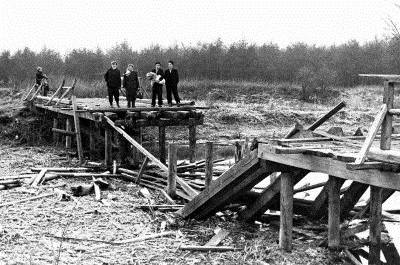
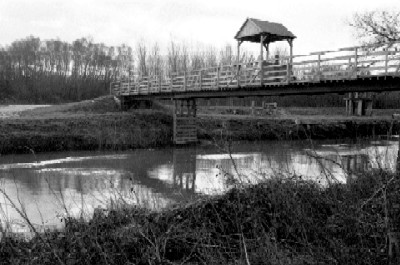 Andau Bridge: (left) blown up by the Soviets on Nov 21, 1956; (right) as restored in 1996 While the fighting was still going on in Hungary, many women and children were sent over the border for their protection. Later, when the fighting ceased many young men crossed the border. [12] The refugees included entire families, people of all ages, students, and even orphans. The reasons for their flight ranged from the fear of political repression as a consequence of the revolution to the long-cherished wish to escape the communist regime. More then half of the refugees came from the capital city of Budapest, while the rest hailed almost exclusively from the western regions of Hungary. About 4 percent of the national population fled; the percentage from the city of Sopron was as high as 12 percent. Two-thirds of the refugees were male, with more than half under the age of 25. [13] There were also a certain number of soldiers amongst the refugees. In accordance with international law, the Austrian Ministry of Defense decided to open four internment camps for all refugees carrying weapons and those clearly recognizable as military personnel. By December 1956 more than a 1,000 people were held in the largest internment camp in Salzburg, Wals-Siezenheim. The interned refugees were practically prisoners; they could not move about freely, and their chances of being accepted by other countries were slim. The Austrian authorities were forced to improvise since no infrastructure existed to receive such a massive influx of persons. Red Cross officials tried to collect and group the refugees behind the border. The refugees, many totally exhausted and nearly frozen to death, were first taken to schools or restaurants. They were then transferred in larger groups to a refugee camp in Eisenstadt, the capital of Austria’s border province, Burgenland. From there public trains or buses brought them to a large camp called Traiskirchen to the south of Vienna. Finally, by mid-November, when things became better organised, the refugees were distributed among different camps all over the country. However, the existing camps were soon filled and the stream of refugees did not cease. By mid-November 1956, when the wave of refugees reached its peak, Austrian newspapers referred to the situation in the border regions as catastrophic. Officials did not know where to put the newly arriving refugees since every possible place was already occupied. At times the border patrols even told refugees to come back in a couple of days in the hope that the situation would improve. [14] Primitive camps instead of the “Golden West” Where should thousands of refugees be taken in a country which was still recovering from the hardships of the Second World War and which still took care of around 120,000 refugees? The only practical possibility was to house the new refugees in empty war-damaged houses and any abandoned building of the former occupation forces that remained unused. In the beginning, the new “camps” consisted only of empty rooms, some even without water or electricity. In some cases toilets, windows, and doors were broken or lacking altogether. The refugees had to sleep on straw, which had to be brought in by local farmers. [15] This situation worsened after November 4. On that day alone more than 5,000 refugees crossed the border. However, following the initial surprise, chaos gave way to better organisation and management. Soon every refugee received a minimum of 2,400 calories of daily nutrition, and clean and warm clothes were distributed, along with pocket money, toiletries, and cigarettes. Sanitary facilities were built and medical care was supplied. 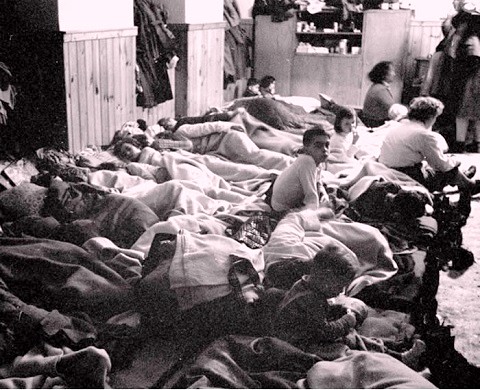 Nevertheless,
life in the camps caused distress amongst the refugees. They lived together in cramped and
narrow spaces, and had little means of physical or intellectual activity. The Interior Ministry
tried to cope with this situation and asked all contributing aid organisations to attend to the
cultural and religious needs of the refugees. Radio, newspapers, films, literature in Hungarian
language, sports and other activities were called for. [16] Many organizations reacted
positively, and provided courses in baseball, football and ballet, dancing lessons, and theatre
groups. Even a small orchestra was organized. Buses with Hungarian literature arrived at the
camps and informative newspapers were published in various Austrian provinces informing the
refugees about legal rights, asylum law, and the possibilities of emigration to other countries.
Furthermore, the diverse religious needs of the refugees were also provided for. Nevertheless,
life in the camps caused distress amongst the refugees. They lived together in cramped and
narrow spaces, and had little means of physical or intellectual activity. The Interior Ministry
tried to cope with this situation and asked all contributing aid organisations to attend to the
cultural and religious needs of the refugees. Radio, newspapers, films, literature in Hungarian
language, sports and other activities were called for. [16] Many organizations reacted
positively, and provided courses in baseball, football and ballet, dancing lessons, and theatre
groups. Even a small orchestra was organized. Buses with Hungarian literature arrived at the
camps and informative newspapers were published in various Austrian provinces informing the
refugees about legal rights, asylum law, and the possibilities of emigration to other countries.
Furthermore, the diverse religious needs of the refugees were also provided for.Despite all these efforts, doctors detected a “camp psychosis” among the refugees, which manifested itself in passivity, depression, and latent aggressiveness. [17] These symptoms were especially noticeable in the internment camp in Salzburg, from whence many of the internees tried to flee in order to sneak into a “normal” camp. In mid-November 1956 around 100 internees held a hunger strike to protest against the way they were treated, and later that month disturbances there required police intervention to restore order. [18] In mid-December 1956 the director of security in Burgenland reported that the formerly thankful Hungarians had become more and more dissatisfied and impatient. In addition, they demanded expensive drugs and were not happy with the medical care. [19] Austrian officials were of course less than pleased by these complaints. A document from the Ministry of Foreign Affairs noted that the camps were suitably equipped, and more comforts and conveniences would only induce the refugees to stay in Austria. [20] In January 1957 Interior Minister Helmer was forced to make a public declaration that refugees also had duties and criticised those who caused trouble. [21] Chaos and rivalry amongst Austrian institutions and organisations One Austrian newspaper reporting in mid-November 1956 about the strong emotional solidarity shown by the Austrian population concluded that when the “cool head gets lost,” help turns into confusion. [22] Despite the admirable work being done, the organization of care for the refugees was hampered by the multitude of aid organizations working in parallel and the rivalry and quarrels among them. The UN High Commissioner Auguste Lindt had the task of coordinating the entire refugee program, while the 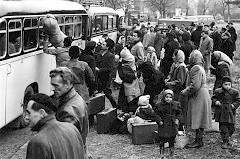 Red
Cross strove to harmonize the efforts of the different humanitarian institutions, and the
Intergovernmental Committee for European Migration (ICEM) took over the registration
and further transport of the refugees. Allegedly 40 organizations were involved in refugee care
in Austria, including the Knights of Malta, Caritas, Rettet das Kind, CARE, the International
Rescue Committee, the Knights of St. John, and the Quakers. Some of the organizations came into
being in a spontaneous manner in response to this crisis and thus were not only un-coordinated,
but also perceived other organizations as rivals. The president of the Austrian Red Cross, for
example, refused to collaborate (at least for a while) with other organizations in assessing the
camps’ needs. [23] At times the understanding between the Red Cross and the Austrian authorities
deteriorated to the extent that the former threatened to stop its food shipments. [24] Red
Cross strove to harmonize the efforts of the different humanitarian institutions, and the
Intergovernmental Committee for European Migration (ICEM) took over the registration
and further transport of the refugees. Allegedly 40 organizations were involved in refugee care
in Austria, including the Knights of Malta, Caritas, Rettet das Kind, CARE, the International
Rescue Committee, the Knights of St. John, and the Quakers. Some of the organizations came into
being in a spontaneous manner in response to this crisis and thus were not only un-coordinated,
but also perceived other organizations as rivals. The president of the Austrian Red Cross, for
example, refused to collaborate (at least for a while) with other organizations in assessing the
camps’ needs. [23] At times the understanding between the Red Cross and the Austrian authorities
deteriorated to the extent that the former threatened to stop its food shipments. [24]In addition, collaboration among the Austrian authorities and different ministries was poorly managed. The Austrian Chancellor Figl had tried at an early stage of the crisis to introduce an action-committee to coordinate the Austrian authorities. However, due to the reluctance of the Minister of the Interior, this committee only came into being on November 13. [25] A department called 10 UH (Ungarnhilfe [Hungarian Aid]) had already been set up a week earlier within the Ministry of the Interior, which was to act as an overall coordinator. [26] The Minister also complained about the unsatisfactory collaboration of various local governments. [27] Financial issues never ran smoothly. The Austrian authorities finally struck a compromise with the League of the Red Cross, which assumed the expenses for the larger camps until the summer of 1957. The Austrian Red Cross took over this task until the autumn of that year, and then passed it on to the Austrian Ministry of the Interior. [28] Where should the refugees go? As mentioned above, the Austrian authorities, on October 28, had already contacted their embassies in Paris, London, and Washington, hoping to obtain assistance with the refugee problem. The sheer number crossing the border after November 4 quickly led the government to conclude that it was unable to handle this mass of people alone. It was thus eager for the refugees to move on to other Western countries as soon as possible. However, it became clear almost immediately that many states were more willing to support the Austrians financially in aiding the Hungarian refugees than to open their own borders to them. [29] Austria expected help from all the states that had signed the Geneva Convention, as well as from the other Western European countries and the USA. On November 4, the day of the second Soviet intervention, Helmer sent a telegram to the High Commissioner of Refugees and drew his attention to Austria’s problems. As a result, offers to take in refugees poured into Vienna. The generous promises, however, were not followed by action. To begin with, the transportation of the refugees was slow due to its having been suddenly improvised. [30] Before long the problem of the receiving states’ selection of refugees surfaced. The fact that other countries screened and selected the refugees as immigrants turned into an acute problem when Austria’s capacity to house and feed them reached its limit, and still thousands more kept arriving every day. A document from the Ministry of the Interior from November 1956 clearly expresses the view that the usual measure of screening—including selection, medical exams, and the acceptance of only young and working age people—was not appropriate for these special circumstances. Austria would end up having to take care of all the women, children, sick and old people in addition to the sacrifices it had already made. [31] The Austrian UN delegation was adamant in its demands before the UN Plenary session at the end of November: “This measure [the transfer of refugees] should be implemented by a waiver of all bureaucratic formalities. May it be remembered that Austria, too, cannot discriminate at her borders”. [32] Austria tried to make clear that not only the working population but also the elderly people and children had to be transferred along with their families. Austria was especially critical of the screening measures implemented by the United States, which insisted on long medical examinations by the immigration office. They not only made the refugees come to Vienna several times for the medical check-up, but also made sure that “no toes and fingers were missing,” as one Austrian document put it mockingly. [33] In mid-November 1956—when all possible accommodations in Austria were filled to capacity and some school buildings in the Austrian provinces had to been given over to house refugees—Helmer once again complained in the council of ministers about the scant help given by other countries. For example, Switzerland was the only country to accept refugees without any examination and the Netherlands, which had offered to take up to 2,000 refugees, caused “unthinkable difficulties.” Observing that Belgium only wanted to take men and young people, his anger was undisguised: “that’s what the charity of the foreign countries looks like!” Helmer sorrowfully warned, “we now have to speak rightly of a state of emergency. Yesterday refugees were housed in a running train since we have no accommodation left.” [34] On November 17 the Austrian government once again sent a memorandum to all the accredited foreign missions within the country. [35] It demanded that they react positively in regard to three essential measures: the immediate transfer of the refugees to other countries without a previous examination; the provision of financial support; and aid shipments of food, clothing, and other necessities. In a message to the Washington embassy the situation was depicted as follows: “Thousands more people stream into Austria—apparently with the silent toleration of the Soviet authorities. The moment draws closer when Austrian authorities will not even be in a situation to take up the refugees as a stop-gap measure.” [36] Austria also reiterated its appeal at the Plenary Assembly of the United Nations. On November 27 the Austrian delegate Kurt Waldheim explained that 87,000 refugees had fled from Hungary into Austria and that only 20,000 had been transferred to other countries. 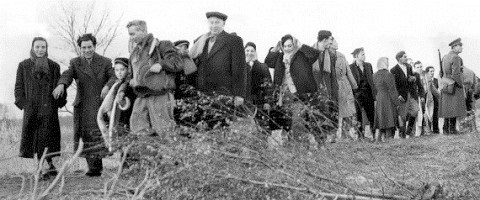 Furthermore,
every day about 8,000 new refugees were arriving. He stressed: “Austria cannot do it alone.
She necessarily depends on generous, joint help from other countries. Reception centres, holiday
homes and empty hotels, all available private housing facilities and even schools, are
completely filled up […] We are confronted with an emergency that can only be met by immediate
measures.” [37] Furthermore,
every day about 8,000 new refugees were arriving. He stressed: “Austria cannot do it alone.
She necessarily depends on generous, joint help from other countries. Reception centres, holiday
homes and empty hotels, all available private housing facilities and even schools, are
completely filled up […] We are confronted with an emergency that can only be met by immediate
measures.” [37]In addition, Austria’s budget was heavily burdened by the outlays for the refugees. Government experts had calculated that the total expenses for food, camps, and medical supplies incurred up to November 7 had exceeded receipts from donations by two million dollars. [38] In late November Waldheim stated before the UN General Assembly: “[…] it has to be understood by all those able to help that the burden Austria is most willingly taking upon herself, is a heavy one and is about to exceed the country’s financial capacities. Austria has already spent 120 million Austrian Schillings, the equivalent of 4.8 million dollars, on refugees from Hungary during the last four weeks. The costs of maintaining the current number of Hungarian refugees in Austria for a period of six months are estimated at 600 million schillings or about 24 million dollars.” [39] The American President, Eisenhower, reacted to the requests of many Hungarians and on December 1 raised the immigration quota from 6,500 to 21,500. However, even this measure was not enough. Alarmed by the situation, the US Vice President, Richard Nixon, visited Austria later that month to gain firsthand experience of the crisis. While there he held talks with the Austrian authorities, inspected the border, and talked to refugees. [40] As has already been commented, many refugees hoped to be given asylum in America. However, the United States immigration laws only permitted refugees from the first country that granted them asylum, which in the case of the Hungarian refugees was Austria. Thus not only did many refugees only reluctantly accept the opportunity to emigrate to a country other than the United States, but this issue also created a serious problem when refugees tried to re-enter Austrian territory after having been transferred to other European countries. [41] As the documents from the Austrian archives cited here clearly show, the transportation of refugees to the other Western countries did not happen fast enough from the Austrian perspective. Nevertheless, this does not diminish the fact that the receiving countries subsequently proved to be very generous and provided real opportunities for the refugees. The Hungarian refugees were resettled in 37 countries. The Austrian Yearbook for 1956 reveals that the US accepted the largest number of Hungarian refugees (19,655), followed by Great Britain (13,018) and West Germany (10,934). However, according to the official statistics there were still 87,725 refugees in Austria at the end of 1956. Another source tells us that by summer 1959, the US had taken in 38,058 refugees, Canada 25,513, and Great Britain 20,690. According to these figures 11,471 refugees remained in Austria at this time. [42] The often admired willingness of the West to accept the Hungarian refugees can partly be explained by the fact that the whole world had closely followed the dramatic showdown in Budapest. It was the first major international crisis to appear on television, and was headline news in newspapers and on cinema newsreels for weeks. In addition, the events were almost always presented and assessed in their Cold War context. After all, every refugee fleeing to the West seemed to prove the democracies’ moral superiority and thus needed to be welcomed. The feeling of guilt in the West (and the public pressure on governments) should also not be underestimated. Many Western governments were happy that “at least something” was being done since the Hungarian people had been left alone in their struggle for democracy. However, it should be noted that the Hungarian refugees fled in a very short time span in relatively small numbers, and the burden they imposed was distributed all over the world. Furthermore, Europe’s economic upsurge had just started and so there were not that many rivals in the labor market. Yet the positive reception of the 1956 Hungarian refugees is even more remarkable if one considers the reluctant attitudes towards displaced people all around the world then still in need of resettlement, for example in Austria, Italy, Germany, Greece, China, or the Middle East. [43] The refugees as a security problem The fact that thousands of refugees stayed in Austria proved especially difficult for Austria’s interior security officials, who were concerned about their political activities. Among the refugees there were many activists who held political discussions, tried to create refugee organizations, and even hoped to continue promoting the ideals of the revolution. By mid-November 1956, when the fighting in Hungary began to die out, more young people who wanted to continue the struggle assembled in Austria. The perturbed Austrian Foreign Minister wrote: “Taking into account the large number of people, it becomes harder and harder for the Austrian authorities responsible to control and prevent the political activities of the refugees. Considering their political danger, immediate transportation of large numbers to other countries is already urgently necessary.” [44] The highest priority was to remove the refugees from the border area in order to prevent possible political incidents. The governor of the eastern province of Burgenland had already detected irredentist activities there. [45] Other authorities also observed that refugees were creating new political organisations. In February 1957 a directive by the Interior Ministry addressed the political and intelligence activities of the Hungarian refugees in Austria: “The Ministry of the Interior is, under no circumstances, willing to tolerate any activity by foreigners in Austria which aims to disturb the peaceful relations of the Republic with other states, or which aims to influence the internal political situation in other countries.” [46] The fact that thousands of Hungarian refugees resided in Austria began to be especially problematic when the secret services from both the East and West tried to take advantage of the situation. American intelligence organisations, for example, tried to hire refugees to go back to Hungary and to serve as agents there. On the other hand, the Hungarian secret police tried to recruit refugees in order to stay informed about developments within Austria. It goes without saying that this was a very delicate situation for a neutral country such as Austria. Repatriation of Hungarian refugees Austria was in a delicate position when it came to the new Hungarian government’s repatriation demands. Ever since early November 1956, the Hungarian government, via its Vienna consulate, demanded that the Austrians not impede those willing to return to Hungary. Since the end of November, the Hungarians were eagerly trying to set up a repatriation commission that was active in the Austrian camps. The Hungarians, having proclaimed an amnesty to all those willing to return, declared they had information about thousands of Hungarian refugees wanting to return to their homes. The Austrian authorities, they claimed, prevented this and forced the refugees to emigrate to other countries. [47] The Austrians were of the opinion that all those willing to leave were not dissuaded from doing so. Any refugee wanting to go back to Hungary had only to sign a written declaration saying that he or she chose to return at his or her own discretion and was willing to be handed over to the Hungarian authorities. One particularly delicate element of this procedure was the establishment of each person’s identity. [48] While Hungary wanted to handle the issue in a bilateral manner, the Austrians strove to internationalize it by involving the UN High Commissioner. A solely Hungarian commission was proposed by the Hungarian government, but the Austrians rejected this idea. Following negotiations between the Austrian authorities and the High Commissioner, a bilateral commission began work in mid-January 1957. The commission consisted of both Austrian and Hungarian representatives, along with an observer sent by the High Commissioner. The refugees who wished to appear before the commission were to be collected in special camps where they had to await the decision of the Hungarian authorities. [49] The Austrian authorities had stated from the very beginning that they could not take responsibility for incidents in camps, given the “known temper of the Hungarians.” [50] Indeed, soon after the arrival of the repatriation commission, the first incident occurred in a refugee camp, when some refugees tried to throw stones at the members of the commission. The police had to intervene to help them depart safely. [51] From that moment on the commission held its meetings not in the refugee camps, but in other official buildings. [52] It is very hard to a give the exact number of repatriated Hungarian refugees. While some sources refer to around 3,000 refugees, others cite around 12,000 by mid-1959. A report from the UNHCR even speaks of 18,200 refugees who eventually returned to Hungary. The Hungarian Foreign Ministry claimed that 13,000 refugees had already returned by January 1958. [53] The question of children and minors became a special case that resulted in a legal conflict lasting for years. The Hungarian government demanded the repatriation of all minors under the age of eighteen, while the Austrian government wanted to send back only those under the age of fourteen. The bulk of the children under 14 were indeed repatriated, and the older children were dealt with individually through the involvement of the High Commissioner. Hungarian demands for establishing a repatriation commission were accompanied by a propaganda offensive from the entire Eastern bloc. An example worth citing is the UN delegate from Belorussia, who alleged that the Austrian government and the UN hampered the efforts of refugees who wanted to return to Hungary. The delegate of the USSR went even further and declared that children who wanted to join their parents back home in Hungary were interned behind barbed wire. [54] The Eastern press portrayed the situation of the refugee camps in Austria in horrific and terrible terms, claiming the refugees were imprisoned in camps with scarce room, and very little food and water. It was also alleged that the Hungarian refugees were being sold as slaves to mines and plantations or were being recruited for the Foreign Legion. [55] Conclusion The sudden eruption of a political or economic crisis can, under certain circumstances, result in massive emigration. This not only has negative effects on the country from which inhabitants are fleeing, as in the well known case of a “brain drain,” but also for the neighbouring countries which are forced to receive the refugees. The exodus of thousands of Hungarian citizens as a consequence of the unsuccessful 1956 Hungarian revolution can be studied as a textbook exemplar of such a situation. The country which was most directly affected by this exodus—at least in the early stages—was Hungary’s western neighbor, Austria. Unlike present-day practice, the Austrian authorities granted asylum to all Hungarian refugees and the international community agreed to classify them as “political refugees,” despite the fact that not all of them satisfied the Geneva Convention’s criteria. The spontaneous direct action and provision of material aid by the Austrian people is an established fact which has been stressed by many scholars. The deep sympathy for the Hungarian refugees can be explained by the synergy of many factors: geographic proximity, the memory of a shared Austro-Hungarian past, Austrian memories of the experience of Soviet occupation from 1945 to 1955, and the integration of the Hungarian revolution into the context of the Cold War. However, as the subsequent transportation of the refugees to other places of asylum failed to occur as quickly as the Austrians had anticipated, the image of the Hungarian refugees in Austria soon deteriorated. After November 1956 there were increasing complaints about both the high costs of aiding the refugees and pessimism about when they would move on to other destinations. The refugees began to be portrayed as a burden to the Austrian state, which was seen as both a humanitarian and political problem. Interior Minister Helmer openly stated that the refugees also had their duties, and the media started to stress that the limits of Austria’s capacity to assist had been reached. Furthermore, initial sympathy soon faded as the thousands of refugees became rivals in the job market and in the search for accommodations. [56] The refugee problem represented a two-fold problem for Austria as a state, in that it posed both a political quandary and a financial and administrative burden. Austria was without a doubt honestly surprised by the sheer magnitude of the sudden influx of refugees. Organisational problems such as poorly equipped camps or conflicts among charity organisations soon surfaced as a result. Austria repeatedly requested help from other Western countries, and was quite upset by their unwillingness to assist. Not only were the masses of refugees simply too much for such a small country; they also constituted a serious security problem. With regard to Austria’s foreign policy, the reception of the refugees raised two issues. On the one hand, Austria was constantly attacked by the Eastern bloc countries in connection with the refugee question, and relations with the Soviet Union and its satellites suffered a severe blow. On the other hand, Austria’s humanitarian actions were widely acknowledged in the West, and Austria became known as a refugee country. For the thousands of refugees, Austria was the first Western country in which they found shelter. This was not only deeply symbolic of Austria’s Western orientation just a year after the Soviet occupation forces had left the country’s Eastern regions, but it was also an unforgettable moment for the refugees themselves. The latter point may be the reason why the former Hungarian refugees who became Austrian citizens continue to shower praise on Austria’s efforts in receiving the 1956 refugee wave. Yet while Austria’s humanitarian actions should not be understated, widely held naive “myths” need to be corrected by also revealing the more complex, and in some senses negative, events that took place. The lessons archival documents teach us—fifty years after the actual events—include the advisability of stepping back and acknowledging that the reception of the refugees in Austria did not happen as smoothly as is normally portrayed. The 1956 exodus of the Hungarian refugees was not only a landmark in Austrian history. The refugee crisis has also left an indelible and enduring mark on an international scale. Most scholars now agree that 1956 was the first example of a generous acceptance of refugees. Even more importantly, it provides a strong argument for framing the settlement of refugee problems in an international context, instead of trying to handle it bilaterally. Without the help of the UNHCR, the ICEM and the various non-governmental organizations, the crisis could not have been solved by Austria alone. The aftermath of the 1956 uprising helped shape the way humanitarian organizations would deal with refugee crises for decades to come. The episode also left a permanent mark on international refugee law and policy. [57] Selected Bibliography: Beyer, Gunther. “The Political Refugee: 35 Years Later.” In Theories of Migration, ed. by Robin Cohen, 96-105, Cheltenham: Elgar, 1996. Ceresnyés, Ferenc. “Ötvenhatosok menekülése Ausztriába és Ausztrián át.” Múltunk 1 (1998): 42-70. Engelke, Edda. Ungarnflüchtlinge in der Steiermark. Vienna: Studienverlag, 2006. Gáal, Károly, and Roland Widder (eds.). 1956 und das Burgenland: Berichte über die Hilfsaktionen für ungarische Flüchtlinge. Eisenstadt: Burgenländische Landesregierung, 1996. Goodwin-Gill, Gill. The Refugee in International Law. Oxford: University Press, 1996. Granville, Johanna. “Of Spies, Refugees and Hostile Propaganda: How Austria Dealt with the Hungarian Crisis of 1956.” History 91 (2006): 62-90. Haslinger, Peter. “Zur Frage der ungarischen Flüchtlinge in Österreich 1956-1957.” In Migrationen und ihre Auswirkungen. Das Beispiel Ungarn 1918-1995, ed. by Gerhard Seewann, 147-162. Munich: Oldenburg, 1997. Hoff, Hans and Hans Strotzka. Die psychohygienische Betreuung der ungarischen Neuflüchtlinge in Österreich 1956-1958. Vienna: Holllinek, 1958. Kern, Friedrich. Österreich: Offene Grenze der Menschlichkeit. Die Bewältigung des ungarischen Flüchtlingsproblems im Geiste internationaler Solidarität. Vienna, 1959. Loescher, Gill. Beyond Charity: International Cooperation and the Global Refugee Crisis. New York-Oxford: Oxford University Press, 1996. Michener, James. The Bridge at Andau. New York: Fawcett, 1957. Murber, Ibolya. Flucht in den Westen 1956. Ungarnflüchtlinge in Österreich und Liechtenstein. Feldkirch: Rheticus, 2002. Murber, Ibolya, and Zoltán Fónagy (eds.). Die ungarische Revolution und Österreich 1956. Vienna: Czernin, 2006. Rasky, Béla. “‘Flüchtlinge haben auch Pflichten.’ Österreich und die Ungarnflüchtlinge,” 1956. http://www.kakanien.ac.at/beit/fallstudie/BRasky1 (5.20.2007). Sóos, Katalin. “Ausztria és a Magyar Menekültügy 1956-7” Századok 5 (1998): 1019-1051. Stanek, Eduard. Verfolgt, Verjagt, Vertrieben. Flüchtlinge in Österreich von 1945-1984. Vienna: Europaverlag, 1985. Stedingk, Yvonne (ed.), Die Organisation des Flüchtlingswesens in Österreich seit dem Zweiten Weltkrieg. Vienna: Braumüller, 1970. Szépfalusi, István. “A legújabb felismeresek az 1956/57-es Magyar menekülthullámról.” Limes. Komáron-Estergom Megyei Tudmányos Szemle 1 (1998): 113-122. Zierer, Brigitte. Politische Flüchtlinge in österreichischen Printmedien – dargestellt am Vergleich des Ungarischen Volksaufstandes und der Revolution in Rumänien 1989. Ph.D. Thesis. Vienna University, 1995. Notes: 1. Ministerratsprotokoll, 30.4.1957 in Österreichisches Staatsarchiv, Archiv der Republik (hereafter: ÖStA, AdR), BKA/Ministerratsprotokolle, 2. Republik, Raab II. 2. The official ceremony took place at the “Austria Center” in Vienna on October 17, 2006. Hungary, represented by Prime Minister Gyurcsány and president Solyóm, set out to solemnly thank Austria for its efforts to help the Hungarian refugees in 1956. President Solyóm stated: “Austria, its state and people, has offered such a high moral performance which serves as an example up to this date.” The Austrian President and Chancellor were awarded the highest Hungarian decorations. The Austrian officials, headed by Chancellor Schüssel and President Fischer, in turn were thanked for the positive role of the Hungarian refugees who had stayed in Austria. Pester Lloyd, 10.17.2006. 3. Michener, James. The Bridge at Andau. New York: Fawcett, 1957, 244. 4. Telegramm des Relief Committee For a Free Hungary an Figl, in ÖStA, AdR, BKA/AA, II-Pol 1956/Ungarn 3a, GZl. 511.190, Zl. 520.448. 5. The Hungarian revolution of 1956 was a spontaneous nationwide revolt against the Communist government of Hungary and its Soviet-imposed policies. It started on October 23, 1956 with a student demonstration in Budapest. The revolt spread from the capital across the country while the Soviet troops and the Hungarian State Security could not gain the upper hand. A new government headed by the communist reformer Imre Nagy was established. He disbanded the hated State Security, declared Hungary’s intention to withdraw from the Warsaw Pact, and pledged to re-establish free elections. On November 4, a large Soviet force invaded Budapest and crushed the revolution, killing thousands of civilians. Repression and mass arrests followed, and the opposition was surpressed. 6. In the aftermath of the Second World War Austria was a transit country for masses of refugees and Displaced Persons (DPs). In 1946 around 1.4 million refugees were counted in Austria; by 1955 around one-fifth of them (245,000) had received Austrian citizenship. In the summer of 1956, of the 127,000 persons who had the status of refugees in Austria, 18,000 came from Hungary. At that point many of the earlier refugees continued to live in camps. See Stedingk, Yvonne (ed.). Die Organisation des Flüchtlingswesens in Österreich seit dem Zweiten Weltkrieg. Vienna: Braumüller, 1970, 25. 7. Among these early refugees were a certain number of Hungarian communists who fled what they believed would be a successful revolution. Even around 120 members of the feared Hungarian secret police (ÁVO) found their way to Austria. See Stanek, Eduard. Verfolgt, Verjagt, Vertrieben. Flüchtlinge in Österreich von 1945-1984. Vienna: Europaverlag, 1985, 60. 8. It should be noted that the risk of such a proclamation was quite high and that the Austrian government counted on only about 10,000 refugees at that time. 9. As one soldier guarding the border recalled: “We were always asked over the radio if a jeep or a Dodge should be sent [to pick up the refugees]. Most of the time we said that they should go ahead and send a Dodge in order to fit everybody in since a couple of meters away we usually find more refugees anyhow.” Gáal, Károly, and Roland Widder (eds.). 1956 und das Burgenland: Berichte über die Hilfsaktionen für ungarische Flüchtlinge. Eisenstadt: Burgenländische Landesregierung, 1996, 198. 10. Already during these crucial times, Austrian officials put forward the interpretation that the Soviets let the Hungarians escape on purpose hoping that all the hopelessly anti-Soviet elements would be eliminated from Hungarian society. Österr. Botschaft Belgrad an BKA/AA, 1.12.1956, in ÖStA, AdR, BKA/AA, II-Pol/Ungarn 3d, GZl. 511.190-Pol/56, Zl. 791.898. 11. For some time it was the only escape route to the “free” West before the Soviet troops blew up the bridge. After that the refugees crossed the channel either by boats or swam in the freezing cold water. 12. Erklärung des Gesandten Waldheim in der III. Kommission, 11.27.1956, in ÖStA, AdR, II-Pol 1956/Ungarn 3c, GZl. 511.190-Pol/56. 13. Rasky, Béla, “‘Flüchtlinge haben auch Pflichten.’ Österreich und die Ungarnflüchtlinge 1956.” http://www.kakanien.ac.at/beit/fallstudie/BRasky1 (5.20.07), 4. 14. Haslinger, Peter. “Zur Frage der ungarischen Flüchtlinge in Österreich 1956-1957.” In Migrationen und ihre Auswirkungen. Das Beispiel Ungarn 1918-1995. Ed. Gerhard Seewann. Munich: Oldenburg, 1997, 154. 15. While the refugees sleeping on straw created an evident fire risk, the Austrian Interior Minister’s statement before the council of ministers showed more concern for Austria’s reputation than for the sake of the refugees: “The price of this could be Austria’s considerable reputation abroad.” Ministerratsprotokoll, 11.13.56, in ÖStA, AdR, BKA/Ministerratsprotokolle, 2. Republik, Raab II. 16. Haslinger, “Zur Frage,” 151. 17. Hoff, Hans and Hans Strotzka. Die psychohygienische Betreuung der ungarischen Neuflüchtlinge in Österreich 1956-1958. Vienna: Holllinek, 1958, 31. 18. Ceresnyés, Ferenc. “Ötvenhatosok menekülése Ausztriába és Ausztrián át.” Múltunk 1 (1998): 56. 19. Tiroler Sicherheitsdirektion an Bundesministerium für Inneres (hereafter: BMfI), in ÖStA, AdR, BMfI, GZl. 368.251-2/56, Zl. 368.251-2/56. 20. Haslinger, “Zur Frage,” 155. 21. Zierer, Brigitte. Politische Flüchtlinge in österreichischen Printmedien–dargestellt am Vergleich des Ungarischen Volksaufstandes und der Revolution in Rumänien 1989. Ph.D. Thesis. Vienna University, 1995, 484. 22. Die Presse, 11.16.56. 23. Haslinger, “Zur Frage,” 154. 24. Gáal, Widder, 1956 und das Burgenland, 25. 25. Ministerratsprotokoll, 11.13.1956, in ÖStA, AdR, BKA/Ministerratsprotokolle, 2. Republik, Raab II. 26. Kern, Friedrich. Österreich: Offene Grenze der Menschlichkeit. Die Bewältigung des ungarischen Flüchtlingsproblems im Geiste internationaler Solidarität. Vienna, 1959, 27. It was time for coordination. On November 5, the US ambassador Thompson called the Austrian Ministry of Foreign Affairs and asked it to do something about coordinating aid for the Hungarian refugees. He remarked that such a mess and the glaring lack of communication among the different ministries, the Red Cross, and other private organisations led him to think that the Austrian authorities had lost control over the situation. Amtsvermerk, 11.06.56, in ÖStA, AdR, BKA/AA, II-Pol 1956/Ungarn 3d, GZl. 511.190-Pol/56, Zl. 519.915-Pol/56. 27. Ministerratsprotokoll, 11.13.1956, in ÖStA, AdR, BKA/Ministerratsprotokolle, 2. Republik, Raab II. 28. Vereinbarung über die Ungarn-Flüchtlingshilfe in Österreich, 12.12.56, in ÖStA, AdR, BKA/AA, II-Pol/Ungarn 3d, GZl. 511.190-Pol/56; Kern, Österreich, 89. 29. In addition, the Hungarian refugees were at that point not pleased about leaving Austria since they either wanted to await the final outcome of the situation in Hungary or were still hoping for other family members to join them. The fact that most refugees hoped to emigrate to the United States and not to any other country did not help the situation either. 30. A plane belonging to the French Red Cross landed in Vienna on November 7 with medicine and picked up refugees on its way back home. The next day, the first transport left for Switzerland. Sweden, Belgium, and the Netherlands used buses. However, given the masses of refugees, what was needed was coordinated action. 31. Amtsvermerk, 11.15.56, in ÖStA, AdR, BKA/AA, II-Pol 1956/Ungarn 3d, GZl. 511.190-Pol/56, Zl. 520.422-Pol/56. 32. Erklärung des Gesandten Waldheim in der III. Kommission, 11.27.56, in ÖStA, AdR, II-Pol 1956/Ungarn 3c, GZl. 511.190-Pol/56. 33. Haslinger, “Zur Frage,” 157. 34. Ministerratsprotokoll, 11.13.56, in ÖStA, AdR, BKA/Ministerratsprotokolle, 2. Republik, Raab II. 35. Telegramm BKA/AA an Österr. Botschaft in Moskau, 11.17.56, in ÖStA, AdR, II-Pol 1956/Ungarn 3c, GZl. 511.190, Zl. 520.565. 36. BKA/AA an Botschaft Washington, 11.17.56, in ÖStA, AdR, II-Pol 1956/Ungarn 3c, GZl. 511.190, Zl. 520.440. 37. Erklärung des Gesandten Walheim in der III. Kommission, 11.27.56, in ÖStA, AdR, II-Pol 1956/Ungarn 3c, GZl. 511.190-Pol/56. 38. Gesamtaufwand für Flüchtlinge aus Ungarn, in ÖStA, AdR, BKA/AA, II-Pol 1956/Ungarn 3d, GZl. 511.190-Pol/56, Zl. 520.048-Pol/56. 39. Erklärung des Gesandten Waldheim in der III. Kommission, 11.27.1956, in ÖStA, AdR, II-Pol 1956/Ungarn 3c, GZl. 511.190-Pol/56. 40. Informationen für den Herren Bundesminister, 12.12.56, in ÖStA, AdR, BKA/AA, II-Pol/Ungarn 3d, GZl. 511.190-Pol/56, Zl. 791.815-Pol/56; Amtsvermerk, 12.21.56, in ÖStA, AdR, BKA/AA, II-Pol 1956/ Ungarn 3d, GZl. 511.190-Pol/56, Zl. 792.188-Pol/56; Amtsvermerk, 12.21.56, in ÖStA, AdR, BKA/AA, II-Pol 1956/ Ungarn 3d, GZl. 511.190-Pol/56, Zl. 792.159. 41. There were cases in which refugees announced that they wanted to return to Hungary and once in Austria they refused to travel any further. This upset the Austrian Foreign Minister Leopold Figl who said in the council of ministers on January 15, 1957: “Even our people are already going mad over this refugee story. We cannot be the benefactor of the entire world…. We cannot make any concessions, otherwise we will get all of them [the refugees] back.” Ministerratsprotokoll, 1.15.57, in ÖStA, AdR, BKA/Ministerratsprotokolle, 2. Republik, Raab II. The Austrian government decided to close its border to returning refugees unless it was guaranteed that they would really proceed back to Hungary. Ministerratsvortrag, 1.21.57, in ÖStA, AdR, BKA/Ministerratsprotokolle, 2. Republik, Raab II. 42. Kern, Österreich, 68. 43. Loescher, Gill. Beyond Charity: International Cooperation and the Global Refugee Crisis. New York-Oxford: Oxford University Press, 1996, 71. 44. BKA/AA an Botschaft Washington, 11.17.56, in ÖStA, AdR, II-Pol 1956/Ungarn 3c, GZl. 511.190, Zl. 520.440. 45. Ministerratsprotokoll, 12.04.56, in ÖStA, AdR, BKA/Ministerratsprotokolle, 2. Republik, Raab II. 46. Weisung des BMfI, Generaldirektion für die Öffentliche Sicherheit, 2.01.57, in ÖStA, AdR, BMfI, GZl. 28.000-2/60, Zl. 32.752-2/57. 47. Ungarische Verbalnote, in ÖStA, AdR, BKA/AA, II-Pol 1956/ Ungarn 3d, GZl. 511.190-Pol/56, Zl. 792.243-Pol/56. Up until mid-December, only 500 persons had gone back to Hungary, whereas more than 1,000 had crossed the border daily despite the restrictive measures taken on the Hungarian side. Amtsvermerk, 12.27.56, in ÖStA, AdR, BKA/AA, II-Pol 1956/ Ungarn 3d, GZl. 511.190-Pol/56, Zl. 792.110. 48. Österreichische Neue Tageszeitung, 1.22.56, in ÖStA, AdR, BKA/AA, II-Pol 1956, Ungarn 6. 49. Arbeiter-Zeitung, 2.02.57, in ÖStA, AdR, 02, BPD, Ungarn, Liasse Ungarische Revolution. 50. Amtsvermerk, 12.27.56, in ÖStA, AdR, BKA/AA, II-Pol 1956/ Ungarn 3d, GZl. 511.190-Pol/56, Zl. 792.110. 51. Die Presse, 2.07.57, in ÖStA, AdR, 02, BPD, Ungarn, Liasse Ungarische Revolution. 52. Die Presse, 2.08.57, in ÖStA, AdR, 02, BPD, Ungarn, Liasse Ungarische Revolution. 53. UNHCR, World’s Refugees, 30-31. 54. Vertretung bei den Vereinten Nationen an BKA/AA, 12.07.56, in ÖStA, AdR, II-Pol 1956/Ungarn 3c, GZl. 511.190, Zl. 791.946. 55. Prawda, 25.11.1956, in Sowjetpresse über Österreich, in ÖStA, AdR, BKA/AA, II-Pol 1956, Ungarn 6, GZl. 519.644-Pol/56, Zl. 791.431-Pol/56. 56. Zierer, Ungarnflüchtlinge, 169. 57. The various intergovernmental organisations such as the UNHCR and the Red Cross became more important as a result of the crisis. The UNHCR emerged much strengthened and its international prestige considerably enhanced. It was significant that the UNHCR at this time got its first foothold in Communist bloc countries, namely Hungary and Yugoslavia (where it established a temporary office). The Hungarian exodus provided the UNHCR with its first experience of handling a massive refugee wave and provided its first opportunity to work hand in hand with the Societies of the International Red Cross and the League of the Red Cross. |
4) NEW FEATURES AT DNA.LAND
If you are interested in sharing your DNA for such research (or just want to see these types
of results about yourself), you should consider joining and uploading your autosomal data. Like
GEDmatch, adding your data and using these resources is free. |
5) HISTORICAL BB NEWSLETTER ARTICLES Editor: This is part of our series designed to recycle interesting articles from the BB Newsletters of 10 years ago. In the January 2007 edition, Gerry published an article that included a letter from a Burgenland priest... first-hand info is always good! THE BURGENLAND BUNCH NEWS No. 159 January 31, 2007 A LETTER ABOUT MOSONSZENTJÁNOS (by Gerry Berghold) In purging my files, I came across this letter sent to me by a BB member some time ago; I no longer know who sent it. It was extracted from a "History of the Lang Family" by one Viola Lang Campion in June of 1987. The letter was written by a Father Csoka in the first half of the 1960's.  Father
Csoka writes (edited): "Now something about Mosonszentjános (Sankt Johann): This and the
surrounding villages were inhabited by people speaking German. We don't know when they settled
here. The Hapsburgs brought them there, probably from Baden-Wurttemberg; the records were lost
during the Turkish Wars. Before 1700, the inhabitants were Evangelist (Lutheran) for about 50-60
years. Then Empress Maria Theresia became Catholic again and they had to become Catholic also.
Our records start from 1701. Father
Csoka writes (edited): "Now something about Mosonszentjános (Sankt Johann): This and the
surrounding villages were inhabited by people speaking German. We don't know when they settled
here. The Hapsburgs brought them there, probably from Baden-Wurttemberg; the records were lost
during the Turkish Wars. Before 1700, the inhabitants were Evangelist (Lutheran) for about 50-60
years. Then Empress Maria Theresia became Catholic again and they had to become Catholic also.
Our records start from 1701. "A quarter of Szt. János (100 acres) belonged to big land owners. The rest was held by small farmers with less than 10 acres. Conditions were bad in the 1880's and early 1900's and many of our people went to America. At that time they were Hungarians but they spoke German. In Detroit there are at least 100,000 Hungarians speaking German. After WW-II, many of our people were settled (cleansed?) and sent to Germany. About 1000 are now living in Stuttgart." |
6) ETHNIC EVENTS LEHIGH VALLEY, PA Saturday, February 11: Fasching at the Lancaster Liederkranz. Music by The Continentals. Info: www.lancasterliederkranz.com Sunday, February 12: St. Valentine’s Dance at the Coplay Sängerbund. Music by the Josef Kroboth Orchestra. Info: www.coplaysaengerbund.com Friday, February 24: Fasching at the Evergreen Heimatbund in Fleetwood. Music by Maria & John. Info: www.evergreenclub.org Saturday, February 25: Fasching at the Reading Liederkranz. Music by the Josef Kroboth Orchestra. Info: www.readingliederkranz.com Saturday, February 25: Lumpenball at the Lancaster Liederkranz. Music by the Joe Weber Orchestra. Info: www.lancasterliederkranz.com NEW BRITAIN, CT Friday, February 3, 7 pm: Heimat Abend. Austrian Donau Club, 545 Arch Street, $3. Music by Joe Rogers and his band. Friday, February 17, 7:30 pm: Heurigan Abend. Austrian Donau Club, 545 Arch Street, $3. Music by Schachtelgebirger Musikanten. |
7) BURGENLAND EMIGRANT OBITUARIES Emilie Stadig (née Schmickel)  Emilie
Stadig, 95, of Milford, Massachusetts, died on December 31, at U.Mass. Hospital in Worcester. Emilie
Stadig, 95, of Milford, Massachusetts, died on December 31, at U.Mass. Hospital in Worcester.She was the widow of Gustav Stadig, who died in 1953. Born in Sopron (Ödenburg), Hungary; she was a daughter of the late Martin and Hermina Schmickel. She came to the U.S. in 1946 and first settled in Aberdeen, Maryland. She came to Milford in 1953 and had been a resident since then. Emilie had been employed by the former Hill Food Service of Milford and the former Big D supermarket. She was a member of the Goldstar Wives, the Boy Scouts and the First Congregational Church of Milford. She also assisted for many years at the Community Supper. She is survived by three sons, Edward Stadig of Shrewsbury, Steven Stadig of Milford and David Stadig of Boston, two sisters, Hermina Dinardo of Milford and Irma Smith of Framingham, two grandchildren Jonathan and Stephenie Stadig. A memorial service will be held at a later date. Burial of cremains will be in Arlington National Cemetery. The Watson Colonial Funeral Home, 24 congress St., Milford is assisting the family with arrangements. To leave a condolence go to http://www.watsoncolonialfuneralhome.com. Published in Milford Daily News on Jan. 2, 2017 Theresa Thomas  Theresa
Anna Thomas, 93, of Cabot, Pennsylvania, passed away on January 8, 2017. Theresa
Anna Thomas, 93, of Cabot, Pennsylvania, passed away on January 8, 2017.Born February 6, 1923 in Grieselstein, Austria, she was a daughter of the late John and Theresa (Gumhold) Thomas. She worked as a Secretary for Army Corps of Engineers. She was a member of St. Joseph R.C. Church in Cabot, where she was a Christian Mother, the Austrian-American Cultural Society of Pittsburgh, and Historic Harmony. She enjoyed crafts, sewing and reading. She collected Teddy Bears for about 25 years and enjoyed traveling stateside and overseas. Surviving are many nieces and nephews. She is preceded in death by her parents, one sister, Rose Mary Thomas, two brothers, John Thomas and Joseph Thomas. Friends will be received from Wednesday, January 11, 2017, from 2-4 & 6-8 pm at Fox Funeral Home, Inc., Saxonburg, PA. Services will be held on Thursday, January 12, 2017, 10:00 am at the St. Joseph R. C. Church, with Rev. Mark Pattock, OFM Cap. officiating. Interment will follow in Holy Savior Cemetery. Memorial donations may be made to the Basilica of the National Shrine of the Immaculate Conception 400 Michigan Ave. N.E. Washington, DC 20017, or St. Joseph Church 315 Stoney Hollow Road Cabot, PA 16023. Published in Butler Eagle on Jan. 10, 2017 Johanna Mulholland (née Gülli)  Johanna
M. Mulholland, 99, a longtime resident of Eddy Village Green in Cohoes, New York, passed away on
Tuesday, January 17, 2017. Johanna
M. Mulholland, 99, a longtime resident of Eddy Village Green in Cohoes, New York, passed away on
Tuesday, January 17, 2017.Born in Urbersdorf, Austria, she was the daughter of the late Johann and Theresia (Leitgeb) Gülli. She immigrated to the United States in 1935 and became a citizen on September 3, 1941. Johanna worked for Ford Motor Corporation in Green Island. She was a parishioner of the former St. Peter’s Church in Troy. She was avid bird watcher and watching outdoor activities. Johanna is survived by nieces and nephews in Austria and Canada. She was predeceased by her husband William P. Mulholland, he died in 1973. A calling hour will be held on Wednesday, January 25, 2017 from 2:30 pm to 3:30 pm and a prayer service to follow at 3:30 pm at the McLoughlin & Mason Funeral Home, corner of 109th Street and Third Avenue, Lansingburgh. Interment will follow at St. Peter’s Cemetery, Troy. Please visit www.mcloughlinmason.com. Published in The Record on Jan. 22, 2017 Paula Morris (née Kogler)  Mrs.
Paula Kogler Morris, age 83, currently of Summerville, GA, formerly of Colorado Springs, CO,
passed away at her residence. Mrs.
Paula Kogler Morris, age 83, currently of Summerville, GA, formerly of Colorado Springs, CO,
passed away at her residence.Born in Sopron (Ödenburg), Hungary on April 2, 1933, she was a daughter of the late Johann and Maria (Hammel) Kogler. She and her husband, Donald lived and raised their daughters in Germany. Once he retired they lived in Columbus, GA and Colorado Springs, CO. Mrs. Morris was preceded in death by her husband, Donald Morris and two siblings. Survivors include her three daughters, Carrol Morris and her husband, Steve Brown, Summerville, Marianne Thompson and her husband, Clyde Moore and Theresia Melter, all of Rome. She is also survived by grandchildren, great-grandchildren and two sisters. In accordance with Mrs. Morris’ wishes, she will be cremated and a private service will be held at the Georgia National Cemetery at a later date. Henderson & Sons Funeral Home, North Chapel makes this announcement for the family. Published online on January 27, 2017 courtesy of Henderson & Sons - North Chapel |
| END OF NEWSLETTER (Even good things must end!) |
NOTICE (Informal Terms and Conditions): The Burgenland Bunch (BB) was formed and exists to assist Burgenland descendants in their research into their heritage and, toward that end, reserves the right to use any communication you have with us (email, letter, phone conversation, data upload, etc.) as part of our information exchange and educational research efforts. ● If you do not want your communication to be used for this purpose, indicate that it is "confidential" and we will attempt to abide by that request. ● Correspondents who communicate with the BB without requesting confidentiality retain their copyright but give a non-exclusive license to the BB allowing us to forward to BB members, publish in our monthly newsletter or on our website, and/or subsequently and permanently archive all or parts of such communications. The formal Burgenland Bunch Website Usage Agreement can be found here: Agreement The Burgenland Bunch homepage (website) can be found at: http://www.the-burgenland-bunch.org Burgenland Bunch Newsletter, copyright © 2017 by The Burgenland Bunch All rights reserved. Permission to copy excerpts granted if credit is provided. |
 News
News Online
Cemetery Site: Margaret Kaiser pointed out an online cemetery site, with over 4 million
records, that I previously was unaware of:
Online
Cemetery Site: Margaret Kaiser pointed out an online cemetery site, with over 4 million
records, that I previously was unaware of:  Canadian
Records Site: Speaking of sites that I previously was unaware of, here is one for
indexes to some of the Canadian national censuses:
Canadian
Records Site: Speaking of sites that I previously was unaware of, here is one for
indexes to some of the Canadian national censuses:  There
is also the official Library and Archives Canada site that I've mentioned before:
There
is also the official Library and Archives Canada site that I've mentioned before:


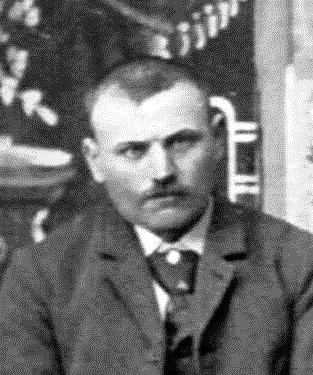 I
was able to track all of these family members except Johann. I know he appeared in Minnesota in
~1894, as he is pictured in a family portrait from that era. I also had the 1938 obituary of my
great-grandmother, wherein he was identified as living in Alberta, Canada. Lastly, I had a US
Port of Winnipeg manifest record showing that a John Halbauer of the right age had tried to
cross the US border in Nov 1921 but was "non-manifest debarred" (not allowed in)... but it had
too little detail to know for sure that it was him. Family lore indicated that he died a
bachelor in Canada and donated his property to a nunnery... but when and where he lived and died
in Canada, I did not know (which bugged me!). Thus I have periodically gone back to search for
new records about him... and recently I hit pay dirt!
I
was able to track all of these family members except Johann. I know he appeared in Minnesota in
~1894, as he is pictured in a family portrait from that era. I also had the 1938 obituary of my
great-grandmother, wherein he was identified as living in Alberta, Canada. Lastly, I had a US
Port of Winnipeg manifest record showing that a John Halbauer of the right age had tried to
cross the US border in Nov 1921 but was "non-manifest debarred" (not allowed in)... but it had
too little detail to know for sure that it was him. Family lore indicated that he died a
bachelor in Canada and donated his property to a nunnery... but when and where he lived and died
in Canada, I did not know (which bugged me!). Thus I have periodically gone back to search for
new records about him... and recently I hit pay dirt!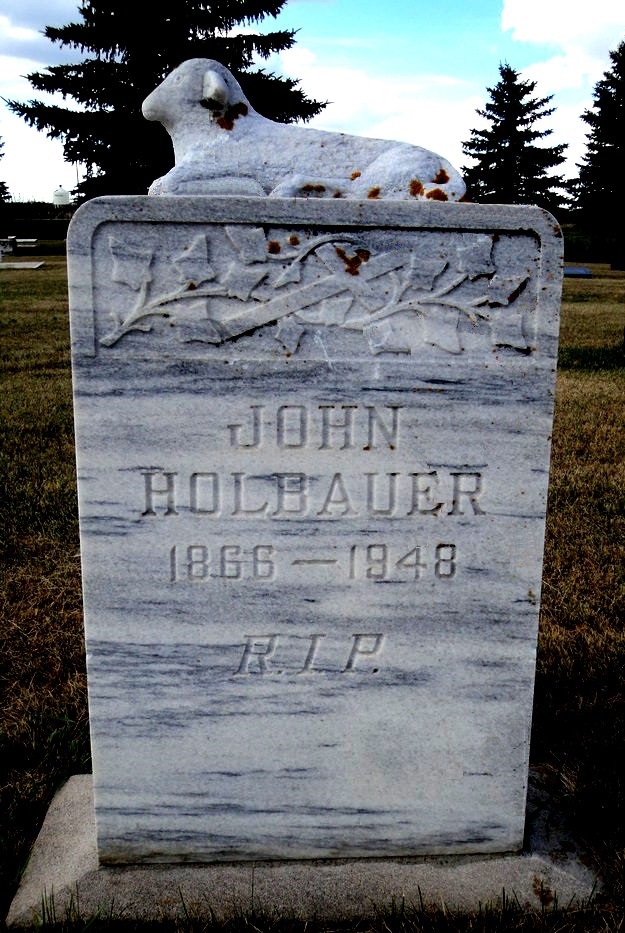 One
thing I found was a burial list for the Catholic cemetery in Heisler... and therein was a
listing for a John Holbauer, complete with a photo of his tombstone! Yes, the name was
off by one letter... Holbauer, not Halbauer, and the birth year was listed as 1866,
not the correct 1867... but if one estimates the birth year from his age, it could be
either 1866 or 1867, so that was no real problem, and phonetic spelling could easily create the
Holbauer error. This John died in 1948, which implies that the "local lady"
who remembered John was likely in her 80s (as she would be at least 69 had she been born the
year John died). Thus the reference to "other old-timers" also seems accurate! And dying
in 1948 worked fine with the obituary reference of living in Alberta in 1938.
One
thing I found was a burial list for the Catholic cemetery in Heisler... and therein was a
listing for a John Holbauer, complete with a photo of his tombstone! Yes, the name was
off by one letter... Holbauer, not Halbauer, and the birth year was listed as 1866,
not the correct 1867... but if one estimates the birth year from his age, it could be
either 1866 or 1867, so that was no real problem, and phonetic spelling could easily create the
Holbauer error. This John died in 1948, which implies that the "local lady"
who remembered John was likely in her 80s (as she would be at least 69 had she been born the
year John died). Thus the reference to "other old-timers" also seems accurate! And dying
in 1948 worked fine with the obituary reference of living in Alberta in 1938. A
Burgenland Blog: Blogger Birgit Platschka writes about herself: "In July 2011 my
husband Bob and I moved from South-Africa to a wonderful little village in Burgenland, called
Eisenberg. This blog is about the little everyday things, that I think about in general or see
here in Burgenland, that are special, sometimes funny but hopefully enjoyable to you. My aim is
to make you forget your stresses for just a few minutes each day."
A
Burgenland Blog: Blogger Birgit Platschka writes about herself: "In July 2011 my
husband Bob and I moved from South-Africa to a wonderful little village in Burgenland, called
Eisenberg. This blog is about the little everyday things, that I think about in general or see
here in Burgenland, that are special, sometimes funny but hopefully enjoyable to you. My aim is
to make you forget your stresses for just a few minutes each day." Update
for book "The Burgenländer Emigration to America": Here is this month's update on
purchases of the English issue of the 3rd edition of Dr. Walter Dujmovits' book "Die
Amerika-Wanderung Der Burgenländer."
Update
for book "The Burgenländer Emigration to America": Here is this month's update on
purchases of the English issue of the 3rd edition of Dr. Walter Dujmovits' book "Die
Amerika-Wanderung Der Burgenländer." "...they
resolved to go back to their own land; because the years, after all, have a kind of emptiness,
when we spend too many of them on a foreign shore. We defer the reality of life, in such
cases, until a future moment, when we shall again breathe our native air; but, by and by,
there are no future moments; or, if we do return, we find that the native air has lost its
invigorating quality, and that life has shifted its reality to the spot where we have deemed
ourselves only temporary residents. Thus, between two countries, we have none at all, or only
that little space of either in which we finally lay down our discontented bones. It is wise,
therefore, to come back betimes, or never."
"...they
resolved to go back to their own land; because the years, after all, have a kind of emptiness,
when we spend too many of them on a foreign shore. We defer the reality of life, in such
cases, until a future moment, when we shall again breathe our native air; but, by and by,
there are no future moments; or, if we do return, we find that the native air has lost its
invigorating quality, and that life has shifted its reality to the spot where we have deemed
ourselves only temporary residents. Thus, between two countries, we have none at all, or only
that little space of either in which we finally lay down our discontented bones. It is wise,
therefore, to come back betimes, or never." BURGENLÄNDER
KRAUT (from Andy Shoredits)
BURGENLÄNDER
KRAUT (from Andy Shoredits) Reminder:
As mentioned a while back, I no longer have a "regular" source for Burgenland recipes. As above,
a few readers have shared favorite family recipes so I'm good for a fair number of months now,
but if contributions stop coming in, I'll be begging by year-end again! So, please consider
sharing your favorite Burgenland recipes or recipe books with me so I can then share them
with the readership... and so our ethnic dishes do not get washed away by the ever-flowing river
of time and become lost to our future generations. Thanks!
Reminder:
As mentioned a while back, I no longer have a "regular" source for Burgenland recipes. As above,
a few readers have shared favorite family recipes so I'm good for a fair number of months now,
but if contributions stop coming in, I'll be begging by year-end again! So, please consider
sharing your favorite Burgenland recipes or recipe books with me so I can then share them
with the readership... and so our ethnic dishes do not get washed away by the ever-flowing river
of time and become lost to our future generations. Thanks!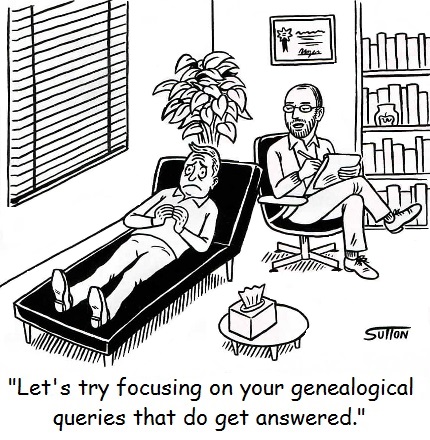
 It
was November of 2015 when I first mentioned the "New Kid on the DNA Block," website DNA.Land
(
It
was November of 2015 when I first mentioned the "New Kid on the DNA Block," website DNA.Land
(